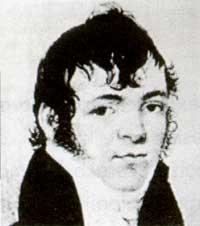Elhuyar, Juan José
(1754-1796)
Joan Jose Elhuyar Zubize was born in Logro6 on June 15, 1754, in a house on Azoka Street. His father (Jean Elhuyar) was from Hazparn and his mother Ursula Zubize, from Donibane Lohizune. Married in 1746 in Donibane, his parents moved to Bilbao (his father was a famous surgeon studied in Paris) and in 1753 to Logroño, where they took the square. That is why the brothers of Juan José were also born in Logroño: Fausto Fermin in 1755 and Maria Lorentza on August 8, 1757.
In 1758 his mother died and his father remarried Dominica Elizagari of San Juan de Luz.

His father's intention was to send John Joseph and Faust to Paris to learn like him. The two brothers arrived in 1772 and worked in the school they called "Le Jardin du Roi". Mineralogy, chemistry, crystallography, physiology, botany, zoology, etc. taught. We know that Juan José worked in botany, but above all he studied chemistry (like his brother Fausto). Professor Hilaire Marin Rouelle apparently was in charge of entering experimental chemistry.
At that time chemistry was undergoing a great revolution. Bismuth, nickel and manganese were then found and the new nomenclature was then being applied. Juan José Elhuyar met works by Lavoisier, Berthollet, Guyton Morveau, Bergman, Scheele, Werner, etc.
In 1777 John Joseph came from Paris to the Royal Seminary of Bergara (created by Xabier Maria Munibe and the Knights of Azkoitia). The following year his brother Fausto was coming to him, but again the two brothers traveled through Europe learning the latest developments in metallurgy and mineralogy, sent by the Minister of the Spanish Navy, who wanted to be aware of the latest advances in the construction of the cannons. After touring Paris, Strasburg, Mannheim, Frankfurt, Leipzig, etc. learned the metallurgical techniques of Abraham Theophile Werner from Freiburg.
In 1781 they went to Austria in spring and from there to Hungary. They were with Born Baron who invented the silver purification system in Vienna.
In 1781, his brother Fausto returned to Bergara, but John Joseph went to Sweden. In Uppsalan he attended the Bergman course. Bergman was very expert in the analysis of minerals with torch and it seems that he analyzed samples of "wolfram" (mineral now called wolframite).
Apparently, John Joseph passed through England and returned to Bergara, and since then both brothers worked together to find wolfram.
It should be noted that Bergara's laboratory was very well equipped. With the presence of the Swedish Tunborg, Uppsalan Tobern Bergman recognized that he had no better. In addition, the "Extracts" of the Acts extracted from 1772 to 1793 can be considered the first scientific journal of the peninsula.
The Elhuyar brothers first isolated in the Bergara laboratory the chemical element called wolfram in 1782 and were published in the Minutes of the General Meetings of Vitoria.
Subsequently, Juan José moved to America to make progress in the mines of Nueva Granada, in present-day Colombia. There he traveled with his brother-in-law Ángel Díaz, married to his sister Lorena, a specialist in metallurgy and mineralogy.
He worked on improving Colombia's mining operations and participated in the famous botanical expedition of Mutis. He proposed to create a special series of military engineers specialized in mineralogy, but this idea did not materialize.
He died in Bogotá for a head attack on September 20, 1796.
Buletina
Bidali zure helbide elektronikoa eta jaso asteroko buletina zure sarrera-ontzian











